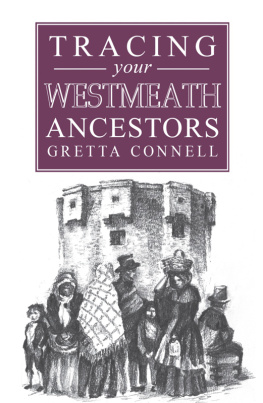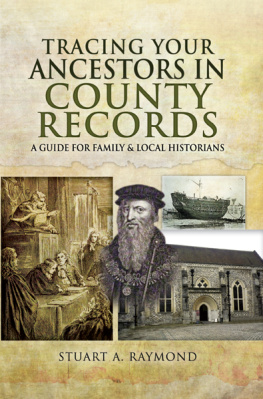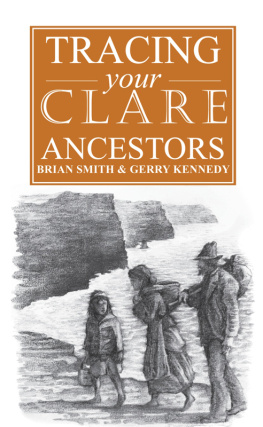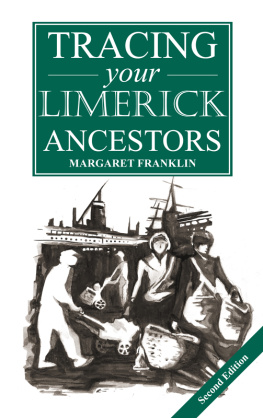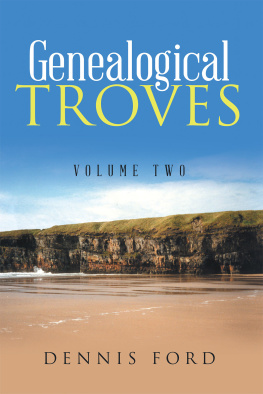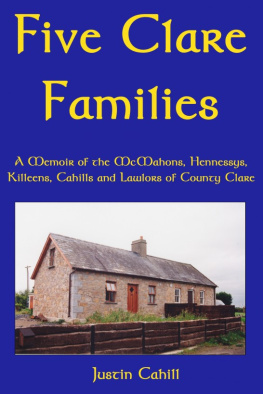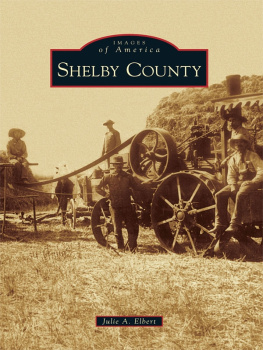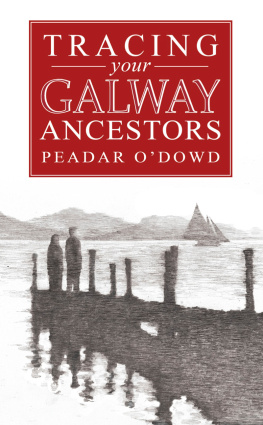Co. Dublin, Ireland
All rights reserved. No part of this publication may be reproduced, stored in a retrieval system, or transmitted, in any form or by any means, electronic, mechanical photocopying, recording or otherwise without the prior permission of the copyright owner.
The information in this book is subject to change without notice.
Acknowledgements
I wish to express my gratitude for the support, advice and encouragement given to me by many people during the course of my research. This book started out as an assignment for a Diploma in Genealogy/Family History Course at the Adult Education Centre, Univeristy College Dublin. I firstly thank the course tutor, Sean Murphy, MA, for his excellent tuition and encouragement. I also thank Mary Farrell, County Librarian for her support; Gearoid OBrien, Senior Executive Librarian Athlone Library for giving generously of his expertise and knowledge especially relating to Athlone and its environs; Martin Morris, Archivist for giving generously of his expertise and knowledge; Paula ODornan, Senior Executive Librarian; Cailin Gallagher, Executive Librarian and all the staff of Westmeath County Libraries who are my friends and colleagues. Thanks also to the principals and staff of the primary schools in Westmeath; Joe OMeara, Coliste Mhuire, Mullingar; Fr. Jimmy Murray, Carmelite Presbytery, Dublin; Sr. Claire, Convent of Mercy, Moate; Sr. Maureen, Convent of Mercy, Rochfortbridge; Mrs. Rosemary Eager, Deputy Principal and Mr. Adrian Oughton, Headmaster, Wilsons Hospital School, Multyfarnham and the staff of Westmeath V.E.C.
Others who deserve thanks include; Mchel Conlin, Westmeath Archaeological and Historical Society; the late Leo Daly, Mullingar; Rev. Declan Smith, Taughmon; Rev. Peter Rutherford, Castlepollard; Rev. Alister Graham, Mullingar; Rev. Graham Doyle, Athlone; Rev. Stephen Lockington, Mullingar; Ruth Illingworth, T.C., Westmeath Archaeological and Historical Society; Peter Wallace, Westmeath Archaeological and Historical Society; Danny Dunne, Mullingar; Billy Standish, Drumcree; William Smyth, Drumcree; Enda Geoghegan, Mullingar; Paul Hughes, Delvin Historical Society; Helen Kelly, Professional Genealogist, Dublin; the staffs of the following institutions: UCD Library; The National Library of Ireland, especially Tom Desmond; The National Archives of Ireland; Representative Church Body Library, Dublin; the Valuation Office, Dublin; the Registry of Deeds, Dublin; the Civil Registration Office, Mullingar; Meath County Library; Longford County Library; Roscommon County Library, Offaly County Library, Fr Ignatius Fennessy, Franciscan Library, Dublin and Teresa Finnerty and staff Dun na S Heritage Centre Moate, Co. Westmeath.
Thanks also to Dr. Jim Ryan and Brian Smith of Flyleaf Press for their support in bringing this work to a successful conclusion, and to Mr John Feeney for his useful comments and suggestions on the final draft.
A special word of thanks to my husband Joe and our children Patrick, Rosemarie, Theresa and Val for their patience and loving support.
Abbreviations
| B | Birth |
| BL | British Library |
| BM | Dr. Beryl F.E. Moore, and Michael Kenny, Headstones in St. Marys Churchyard, Delvin, County Westmeath, 1980. |
| BP | Burgess Papers |
| CoI | Church of Ireland |
| D | Death |
| DED | District Electoral Division |
| M | Marriage |
| GO | Genealogical Office |
| GRO | General Register Office |
| HR | Hazel A. Ryan, Athlone Abbey Graveyard, Mullingar, 1987. |
| IFHF | Irish Family History Foundation |
| Ir. Anc. | Irish Ancestor |
| IAL | Irish Army List (King James Irish Army List) |
| JAPMDI | Journal of the Association for the Preservation of the Memorials of The Dead in Ireland |
| JS | Jeremiah Sheehan, Ed. Beneath the Shadow of Uisneach: Ballymore & Boher, (Ballymore), 1996. |
| MS | Manuscript |
| MWC1 | Mchel Conlin, A Partial List of some Memorials in Westmeath Churchyards. |
| MWC2 | Mchel Conlin, Inscriptions in Westmeath Churchyards, part two. |
| NAI | National Archives of Ireland |
| NLI | National Library of Ireland |
| PRONI | Public Records Office Northern Ireland |
| PW | Peter Wallace, Multyfarnham Parish History, Multyfarnham, 1987. |
| RIA | Royal Irish Academy |
| RCBL | Representative Church Body Library |
| RIC | Royal Irish Constabulary |
| SLC | Salt Lake City |
| SOG | Society of Genealogists (London) |
| TC | Town Council |
| UCD | University College Dublin |
| VEC | Vocational Educational Committee |
| WL | Westmeath Library |
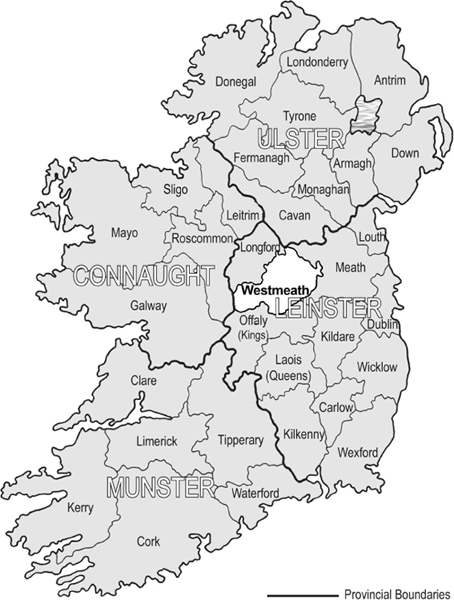
The counties and provinces of Ireland
Chapter 1 Introduction
Westmeath, formerly a part of the ancient kingdom of Meath, was constituted as a county in 1542. It is situated in the Province of Leinster and bounded on the west by County Roscommon, on the north by Longford and Cavan, on the east by Meath and on the south by Offaly (see map page 10). Westmeath is often referred to as the Lake County and is a popular venue for anglers. The county is predominantly flat and fertile arable land and it has a strong agricultural tradition with 84 % of its 454,104 acres being used for dairy and beef cattle farming. Around 8 per cent of the county is under turf bog which was at one time the major source of fuel.
In 1841 the population of of Westmeath was 141,300, but twenty years later, the deaths and emigration of the Great Famine had reduced it to 90,879. Emigration continued and it is estimated that 46,938 left between 1851 and 1891. By 1891 the population was 65,109, or almost half of the 1841 population. The 2006 census records the population at 79,346.
Evidence of inhabitation as far back as 2000 B.C. is proven by the discovery of Bronze Age Burials in Crookedwood in 1933. Christianity came to Ireland in the fifth and sixth century and monastic sites founded in Westmeath and its environs in this period can still be seen e.g. at Fore and, just South of the Westmeath boundary, at Clonmacnoise. The population is predominantly Roman Catholic (92.2 per cent in 1861) but several other religious denominations are also represented.
The families of Westmeath are a mix of Gaelic, Norman and others. Historically, the area was ruled by the Southern ONeills and the seat of the High King was at Uisneach Hill. The major Gaelic familiies in these early times included OFlanagan, MacAuley, MacGeoghegan, OMelaghlin and ODaly

